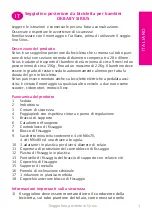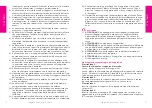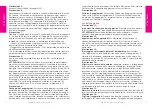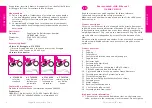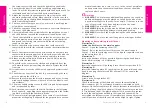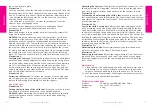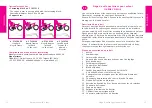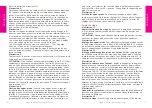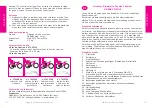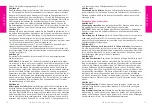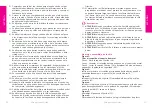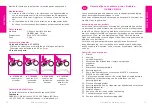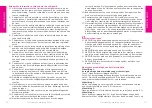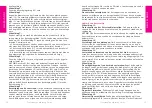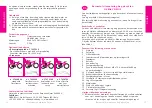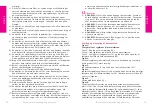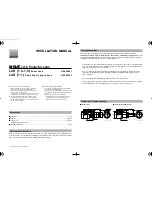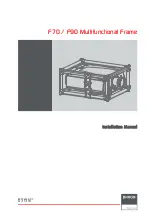
8
9
ENGLIS
H
ENGLIS
H
Sirius rear child‘s seat
Sirius rear child‘s seat
the screws excessively and check the tightness periodically.
2) Check that the bicycle is suitable for adding supplementary
loads. Check the information supplied with the bicycle or ask for
information and advice from the bicycle manufacturer.
3) Adjust the seat and its components in order to give the child
the most comfort and safety. When the child is in the seat, the
backrest should be slightly tilted backwards, so as to prevent the
child from sliding forward.
4) Check to ensure that each part of your bicycle is working prop-
erly with the seat mounted.
5) Check the existence of any laws present in your State that govern
the use of child bike seats.
6) Check initially and then periodically that the weight and size of
the child does not exceed the maximum allowed by the seat.
7) Check that the child or part of its clothes do not come into con-
tact with moving parts of the seat or bicycle. Avoid the child’s
hands and feet coming into contact with the wheel or being
caught in the brakes.
8) Ensure that there are no sharp edges that could come into
contact with the child (for example, frayed or deteriorated wires
etc.).
9) Ensure that the safety belts are not loose and do not come into
contact with the moving parts of the bicycle, especially with the
wheels, even when the child is not being carried in the seat.
10) Always use the safety belts. Make sure your child is properly
secured with the seat belts.
11) The child in the seat must be clothed and protected from the
cold more than the person riding the bicycle. Protect the child
from rain.
12) It is advised to make the child wear an approved protective hel-
met.
13) Check that the seat is not too hot (e.g. overheated by the sun)
prior to placing the child in it.
14) Remove the seat when the bicycle is transported by car. Strong
wind could damage the seat or detach it from the bicycle, caus-
ing accidents.
15) Cover any saddle springs to avoid child’s fingers being trapped
and/or squashed by them.
16) Each time the seat is used, check it is fitted onto the fastening
block correctly: on pulling the support arm upwards, the fasten-
ing block must hold the seat down firmly.
17) The seat material (polypropylene) loses some of its mechanical
properties with ageing if exposed for longer periods to environ-
mental conditions (sun, rain, ice, etc.). In the case of normal use
and exposure to environmental conditions, the seat should be
replaced after 3 years.
Warnings
1) WARNING: Do not place any additional baggage on the seat. Any
additional baggage must be placed on the opposite side of the
bicycle with respect to the seat. For example: if the seat is in the
rear of the bicycle, use a front bag carrier and vice versa.
2) WARNING: Do not modify the seat.
3) WARNING: Riding the bicycle may be different with a child in the
seat, especially regarding balance, steering and braking.
4) WARNING: Never park the bicycle leaving the child unattended in
the seat.
5) WARNING: Do not use the seat if any part is missing or broken.
Mounting and assembling the child seat
Illustration 1:
fasten the backrest to the metal support.
Phase 1 : Open the fastening cover (14)
Phase 2 : Raise the backrest until it rests on the metal support
Phase 3 : Close the fastening cover (14) and push it upwards to hook
on the safety lever (24).
Illustration 2:
Incline the backrest as far as possible by pressing the knob down-
wards whilst rotating it (16) clockwise.
Illustration 3:
Insert the support arm (5) pushing it into the correct position (25).
Illustration 4:
Insert the fastening plate (12) pushing it as far as possible and then
hook it on using the safety tab (26) over wall (27) as seen in the
diagram.
Illustration 5:
Screw on the fixing bracket (13)
Illustration 6:
Check the diameter of the frame and choose the most suitable
plastic adaptor (10). The reference diameter is indicated on each
adaptor. Fix the fastener block (8) and the fastener counter-block (7)
in place, placing the plastic adaptor (10) and the soft plastic reducer
(17) in between them. The plastic adaptor (10) has specific grooves
to hold the cable glands welded to the frame and the cables. Do
not tighten the fastener screws (9) completely so you can adjust the
vertical position of the child seat; when the height is right; tighten
Summary of Contents for SIRIUS
Page 55: ...104 105 自転車用後席幼児座席 Sirius 日本語 自転車用後席幼児座席 Sirius 日本語 ...
Page 56: ...106 107 自転車用後席幼児座席 Sirius 日本語 自転車用後席幼児座席 Sirius 日本語 ...
Page 57: ...108 109 自転車用後席幼児座席 Sirius AR 日本語 n 37430200 n 37430100 n 37430700 n 37430000 ...
Page 58: ...110 111 ...
Page 59: ...112 113 ...
Page 60: ...114 115 ...
Page 61: ...116 ...



